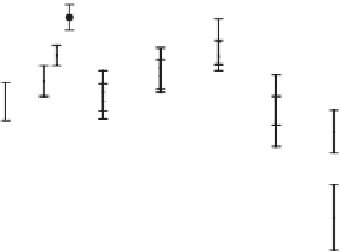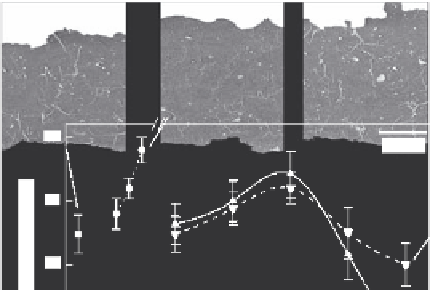Biomedical Engineering Reference
In-Depth Information
Effect of Hydrothermal Crystallization on the Bonding Strength of HACs
failure by chipping, spalling, delamina-
tion, and dissolution is being observed on explanted endoprostheses usually close to the
implant/coating interface [47,196,198]. This can be attributed to the existence of a layer of
ACP formed during rapid quenching of molten or semimolten droplets of calcium phos-
phate with exceptionally high cooling rates at the coating/Ti interface. The ACP layer is
thought to act as a fracture path [199] and owing to its comparatively high solubility will
be preferentially dissolved in vitro and in vivo [76,200,201], thus further weakening the
mechanical integrity of the interface [98,202]. Therefore, it is one of the challenges of coat-
In clinical application, a plasma-sprayed HACs failure by chipping, spalling, delamina-
Cs failure by chipping, spalling, delamina-
]. Therefore, it is one of the challenges of coat-
ing design to reduce the ACP content and improve the adhesion of the coating to substrate
by optimizing spraying parameters, modifying the precursor HA powder, or adding an
intermediate coating layer [40,203-208]. In addition, applying postheat treatments for pro-
98,202]. Therefore, it is one of the challenges of coat-
,202]. Therefore, it is one of the challenges of coat-
202]. Therefore, it is one of the challenges of coat-
for pro-
moting the crystallization of interfacial ACP is another effective method to improve the
interfacial adhesive bonding strength of plasma-sprayed HACs.
The bonding strength of the plasma-sprayed and different heat-treated HACs measured
by the tensile adhesion test according to ASTM C633 is shown in Figure 6.23. For both the
vacuum and atmospheric heat treatments, the bonding strength tends to increase with
increasing the heating temperature up to 600°C, whereas the bonding strength markedly
decreases with further increasing the heating temperature up to 800°C. For the hydrother-
mal treatment, the bonding strength is also significantly improved with the hydrothermal
crystallization of HA, and 150°C hydrothermally treated HACs has a higher bonding
strength (about 38.9 MPa for HT150) than both of the optimal conditions (at 600°C) for
atmospheric and vacuum heat-treated HACs (about 37.1 MPa for AH600, and about 36.0
MPa for VH600, respectively). Considering the cross-sectional features of the HACs also
shown in Figure 6.23, both the 600°C vacuum and atmospheric heat-treated specimens
203-208]. In addition, applying postheat treatments for pro-
-208]. In addition, applying postheat treatments for pro-
208]. In addition, applying postheat treatments for pro-
]. In addition, applying postheat treatments for pro-
s for pro-
40
4
4
4
4
4
4
40
50 µm
50 µm
50
50
50
50
50
5
5
5
5
5
5
5
5
5
5
5
0
µ
µ
µ
µ
µ
µ
µ
µ
µ
µ
µ
µ
µ
µ
µm
35
35
50 µm
30
30
As-sprayed HACs
Hydrothermal
Air heating
Vacuum heating
As-sprayed HACs
Hydrothermal
Air heating
Vacuum heating
25
25
20
20
01
00
400 500
400 500
600
7008
00
01
00
600
7008
00
Temperature (°C)
Temperature (°C)
TiO
2
FIGURE 6.23
Variation of bonding strength correlated with microstructural features after hydrothermal treatment and atmo-
spheric and vacuum heat treatments.



















































































Search WWH ::

Custom Search